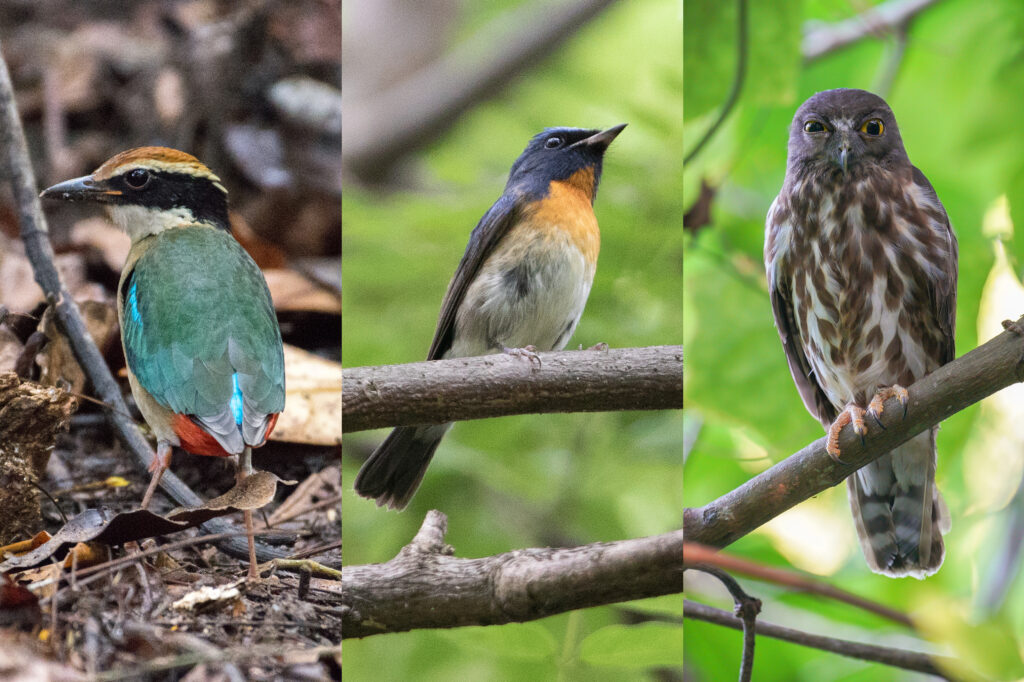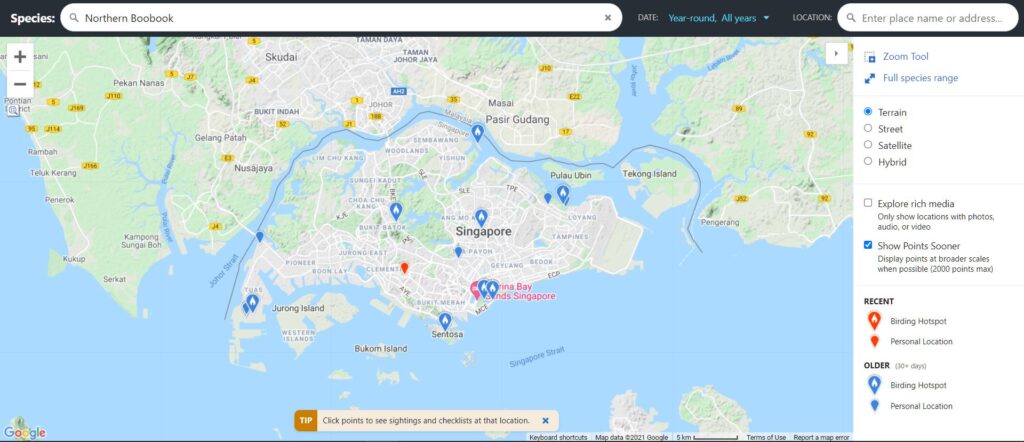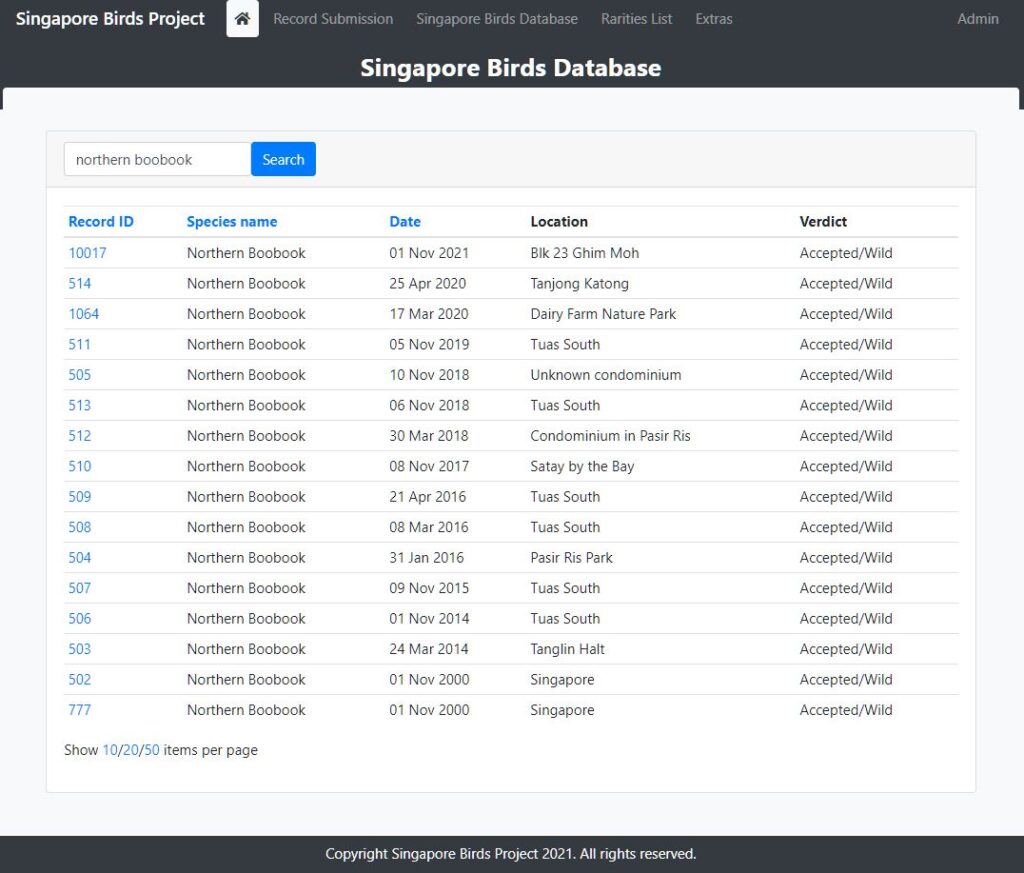~Record keeping with the future in mind~
By Sin Yong Chee Keita & Dillen Ng
Summary
- The Singapore Birds Database contains an easy-to-use search interface that allows you to look up information on locally rare bird species
- More than 1000 records across over 160 species are now freely available to the public
- You can contribute to our project by completing this simple form if you encounter any rare birds
- Feel free to contact us via the Singapore Birds Project regarding any feedback or suggestions
- If you need help with identification, don’t hesitate to ask on our Facebook group where many regionally experienced birdwatchers are present
- To find out more about our philosophy and objectives of this database, check out this write-up
Basic questions but who has the answers?
A Digital Museum. Quite a catchy name, isn’t it? Now that we have grabbed your attention, here are some simple questions that we want to ask you: How many times has the Fairy Pitta been recorded in Singapore? The answer is twice. Easy, right! It’s been all over the news recently. Okay then, what about Chinese Blue Flycatcher? Hmm, there were some recent records but it’s difficult to be certain of the total count. Two? Three? The answer is four. Well, what about the Northern Boobook? Now that’s a tough one. Does anyone have this information at their fingertips…? A rather basic piece of information, it seems—just how many times a species has been seen. Yet no one appears to have the answer.

To find out more, let’s check what Singapore Birds Project has to say about the Northern Boobook.
Local Status: Uncommon migrant
Location: Records from Tuas South, Pasir Ris Park, and Satay by the Bay but could conceivably occur in any place with trees.
This gives us some rough ideas about the species. It certainly is not a common bird, so maybe less than 20 records in total? Still we’d like to know more details. After all, it is still a highly sought after species—knowing where and when to look for it provides clues on the best way to find an individual.
Searching eBird is not particularly effective either. There are a large number of data points with some being repeats of the same sighting, and it would be too time consuming to click through every point on the map.

Finding the answer to this seemingly simple question is actually rather difficult. One would first need to make an excel spreadsheet, click through every eBird data point, then collapse possibly duplicated sightings…and that’s not all. To obtain pre-eBird era information, there would also be a need to flip through old literature to tabulate all records.
This used to be the convoluted journey that any curious birdwatcher had to take to learn about most species, but that will no longer be the case.
Introducing the Singapore Birds Database
Using our newly launched Singapore Birds Database, you can get your answer in just a few clicks. All you need to do is to search for a species name, and voila! We can see that there are at least 16 confirmed local records of the Northern Boobook. How easy is that?!
The Singapore Birds Database contains local records of over 160 species of rare birds. Not only are details on the dates, location and species name of sightings included, we also provide links to primary sources (if available online) such as Facebook or scientific publications so that anybody can verify the data for themselves. For cases where there are records of a rarity at the same (or nearby) location after a period of absence, if we think that multiple records refer to the same individual, we provide internal links so that users can cross-reference the records.

How the Singapore Birds Database was conceptualised
In 2019/2020, we had a tremendous migration season with vagrants such as a Fairy Pitta, Daurian Redstarts, and Taiga Flycatchers showing up. It was quite extraordinary and we worked to publish about its peculiarity together with Singapore’s eBird reviewer, Martin Kennewell. Researching for our paper was very challenging because basic information about a species in Singapore (e.g. how many times has it been seen) was not readily available.
We thought to ourselves, why not create a database to address this problem? In January 2020, we decided to embark on a massive project to compile all records of significant bird species in Singapore. And let’s not just compile it for personal use. Let’s make it public. Let’s make it comprehensive. Let’s make it easy to use. Let’s make sure that it is regularly updated. Let’s make it free to use. And most importantly, let’s make it transparent. We aim for this database to provide records, substantiated with primary evidence, such that users can also question and independently arrive at answers themselves.
We reviewed over 1000 records manually by checking through every available primary source, visiting libraries countless times, and trawling through the web like crazy. After 1.5 years of effort, we are finally ready to launch this database via the Singapore Birds Project website. For those who are keen, you can find out more about the processes and philosophy of our work in this write-up.
How can you be a part of our project?
- If you encounter any rare species, please submit your sighting at this link to play a part in documenting Singapore’s avifauna. We also strongly encourage you to make use of eBird for your day-to-day birding adventures.
- Please let us know if you notice any errors! We will do our best to update the database as soon as possible and with proper acknowledgements.
- Lastly, if you have any ideas for our database or the Singapore Birds Project, feel free to contact us!
Moving forward
All records submitted to our database will be reviewed by the Singapore Birds Project Record Committee. One key focus behind our integrated user submission system and database is transparency, because we believe in making all records and decisions publicly accessible. Given that sightings are shared across a variety of online platforms nowadays, we will continue to actively look out for records of rarities to prevent data from slipping through the cracks, while encouraging user submissions. We aim to cover all bases by being vigilant and using a future ready approach.
The birdwatching community in Singapore has been growing rapidly and everyone is yearning to learn more about our feathered friends. The Singapore Birds Project has filled in the niche for being a reliable source of updated and accurate bird information. This new database is a big step forward in our aim to contribute to the local community. We aim to update our database with more information and explore various avenues to utilise this data. We hope to continue doing our work, not alone, but as a community together with all of you.
Acknowledgements
Raghav Narayanswamy and Francis Yap: A massive thank you to the two of you for creating the digital platform to present our database in such an elegant manner. If not for your efforts, our work would have been constrained to a single excel spreadsheet.
Adrian Silas Tay, Goh Cheng Teng, Lester Tan, Martin Kennewell, Richard White, and See Toh Yew Wai: The feedback all of you provided when testing the initial stages of our database helped improve our public interface tremendously.
Elize Ng, Geraldine Lee, Movin Nyanasengeran, Sandra Chia, Tan Hui Zhen, Twang Fang Qi: Your reviews helped to greatly refine our overarching document that explains the processes behind our work. Thanks for your time in reading through 18 pages of texts. We will probably continue sending you all our future blog posts, so be prepared :p
Martin Kennewell: We are constantly blown away by how you take on the herculean task of curating Singapore’s eBird data with such precision. Your efforts over the past few years in promoting the use of this platform locally is finally paying dividends. Thank you so much for your work!
Bird Ecology Study Group, Lee Kong Chian Natural History Museum, Nature Society (Singapore) Bird Group, Oriental Bird Club: Efforts and publications by these organisations have served as key documentation for numerous historical records, to which we are grateful for.
The past and present administrators of key Facebook groups (Bird Sightings, Birder’s Group, Singapore Birders): Curating content on Facebook is not easy [I know, because I’ve recently become one of them! – Keita] and the efforts have allowed us to search for important information when compiling modern records. Thank you for your effort.
Every single person who has contributed to advancing the local ornithology scene over the past two centuries: Thank you, if not for the efforts of everybody who documented and shared their records, we would be living in a very different community today.
